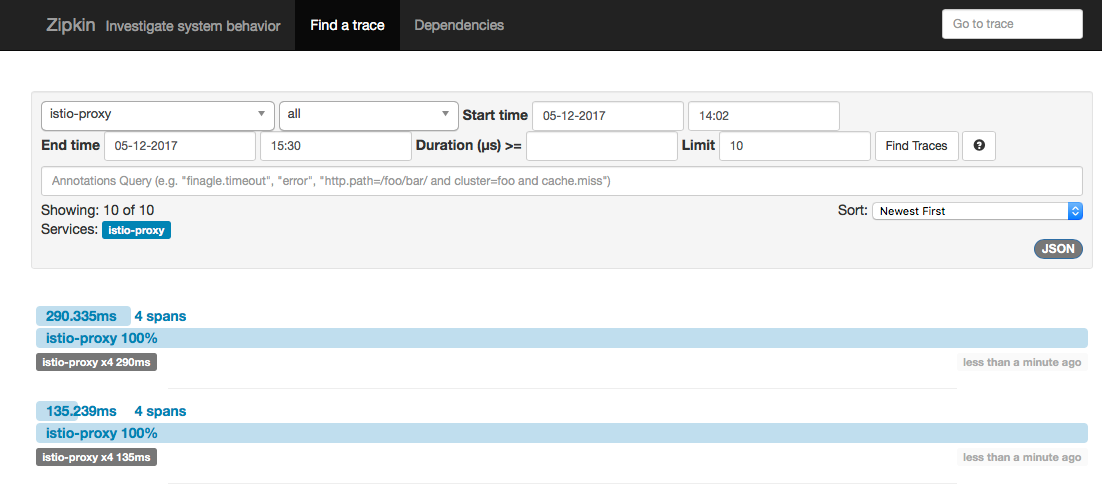6.5 KiB
| title | overview | order | layout | type |
|---|---|---|---|---|
| Distributed Request Tracing | How to configure the proxies to send tracing requests to Zipkin | 120 | docs | markdown |
{% include home.html %}
This task shows you how to configure Istio proxy and related components to collect trace spans using Zipkin. After completing this task, you should understand all of the assumptions about your application and how to have it participate in tracing, regardless of what language/framework/platform you use to build your application.
The BooiInfo sample application is used as the example application throughout this task.
Before you begin
To use the Zipkin implementation, we'll need to do the following pre-work:
- Install the Zipkin service
- Configure Istio components to use Zipkin
These steps are intended to be run when you install Istio's core components. Please see the task for installing Istio
Install the Zipkin service
First, let's install the Zipkin service so that our components/proxies can send span data to it.
-
If you're not already in this directory, change directories to
install/kubernetescd install/kubernetes -
Apply the zipkin yaml resource files
kubectl apply -f addons/zipkin.yaml
You can contine to install the addons as instructed in the task for installing Istio
Configure Istio components to use Zipkin
In step 4 of Installing Istio, we try to apply the istio.yaml file which contains the core components of Istio.
Note: When we install the components for using Zipkin, we will not treat the RBAC scenarios; these steps work when RBAC is NOT enabled for your Kubernetes cluster.
Observe that when we are installing the core Istio components, that we're configuring the manager's discovery service to find Zipkin running at zipkin:9411. That means when the manager configures proxies, they'll know to send spans to that configured location:
# Manager service for discovery
apiVersion: v1
kind: ConfigMap
metadata:
name: istio
data:
mesh: |-
mixerAddress: istio-mixer:9091
discoveryAddress: istio-manager:8080
ingressService: istio-ingress
zipkinAddress: zipkin:9411
When you've completed installing the Zipkin service (from above) and step 4 of Installing Istio, you should be ready to test out the Zipkin dashboard. First, locate the URL (if using an public IP) or try doing a port-forward with the kubectl client:
kubectl port-forward $(kubectl get pod -l app=zipkin -o jsonpath='{.items[0].metadata.name}') 9411:9411
Then open your browser at http://localhost:9411
Setting up the Bookinfo Sample
Now that Zipkin is running and the Istio components are configured to make the proxies Zipkin-aware, we need to install the Bookinfo sample demo. Please review the installation steps for Bookinfo. Feel free to continue on with the demo, invoking the productpage website, and observe the span information in the Zipkin console. You should see something similar to this output:
If you click into a trace you should see the following:
Understanding What Happened
Although the proxies are able to automatically send spans to Zipkin, they'll need some hints to tie together the entire trace. We'll need to propogate the appropriate HTTP headers so that when the proxies send span information to Zipkin, the spans can be correlated correctly into a single trace.
To do this, our application needs to collect and propogate the following headers from the incoming request to any outgoing requests:
x-request-idx-b3-traceidx-b3-spanidx-b3-parentspanidx-b3-sampledx-b3-flagsx-ot-span-context
If you look in the sample applications, you can see that the product-age application (Python) extracts the required headers from an HTTP request:
def getForwardHeaders(request):
headers = {}
user_cookie = request.cookies.get("user")
if user_cookie:
headers['Cookie'] = 'user=' + user_cookie
incoming_headers = [ 'x-request-id',
'x-b3-traceid',
'x-b3-spanid',
'x-b3-parentspanid',
'x-b3-sampled',
'x-b3-flags',
'x-ot-span-context'
]
for ihdr in incoming_headers:
val = request.headers.get(ihdr)
if val is not None:
headers[ihdr] = val
#print "incoming: "+ihdr+":"+val
return headers
The reviews application (Java) does something similar:
@GET
@Path("/reviews")
public Response bookReviews(@CookieParam("user") Cookie user,
@HeaderParam("x-request-id") String xreq,
@HeaderParam("x-b3-traceid") String xtraceid,
@HeaderParam("x-b3-spanid") String xspanid,
@HeaderParam("x-b3-parentspanid") String xparentspanid,
@HeaderParam("x-b3-sampled") String xsampled,
@HeaderParam("x-b3-flags") String xflags,
@HeaderParam("x-ot-span-context") String xotspan) {
String r1 = "";
String r2 = "";
if(ratings_enabled){
JsonObject ratings = getRatings(user, xreq, xtraceid, xspanid, xparentspanid, xsampled, xflags, xotspan);
When you make downstream calls, make sure to include those headers.
What's next
-
Learn more about Metrics and Logs
-
Learn more about Mixer and Mixer Config.
-
Discover the full Attribute Vocabulary.
-
Read the reference guide to Writing Config.
-
If you are not planning to explore any follow-on tasks, refer to the BookInfo cleanup instructions to shutdown the application and cleanup the associated rules.

